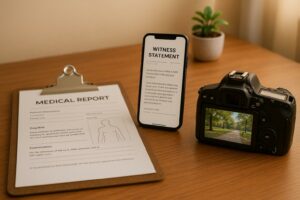If you’re dealing with a personal injury case, here’s what you need to know upfront:
- Timeline: Most personal injury cases are settled within 12 to 14 months, but factors like injury severity, case complexity, and insurance response times can cause delays.
- Steps to Take:
- Get medical care immediately and document everything.
- Collect evidence like photos, police reports, and witness statements.
- Consult a lawyer early to protect your rights and navigate the process.
- Insurance Process: File your claim with all necessary documentation. Be cautious with initial settlement offers – they are often lower than what you deserve.
- Settlement or Court: Most cases settle without going to trial. If necessary, your lawyer will guide you through mediation or court proceedings.
- Final Steps: Once settled, you’ll sign final documents, and the payment process typically takes 3 to 6 weeks.
Key Tip: Patience and thorough documentation are critical. Work closely with your lawyer to ensure fair compensation for your injuries and expenses.
Step 1: First Steps After an Injury
Get Medical Care and Keep Records
After an injury, seek medical attention immediately – even if you feel fine. Shock can mask symptoms, and some injuries may only become noticeable later. In Florida, you need to get medical care within 14 days of an accident to qualify for Personal Injury Protection (PIP) benefits.
Certain injuries may show delayed symptoms:
- Neck and back injuries: These might not appear until hours or even days later.
- Internal injuries: Often missed during initial evaluations.
- Post-traumatic stress disorder (PTSD): Symptoms can develop over time.
Make sure to document every aspect of your medical care:
- Save all medical bills and receipts.
- Keep records of prescriptions.
- Track appointments and follow doctor-recommended treatments.
Collect Evidence
Thorough documentation of the accident scene can strengthen your case. Here’s what to focus on:
| Evidence Type | What to Document | Why It Matters |
|---|---|---|
| Visual Evidence | Photos of injuries, property damage, accident scene | Demonstrates injury severity and conditions. |
| Documentation | Police reports, witness statements | Establishes an official record. |
| Contact Information | Details of other parties and witnesses | Ensures follow-up for testimony. |
| Environmental Factors | Weather, road hazards, lighting conditions | Highlights contributing circumstances. |
If possible, revisit the accident scene at the same time and day to capture typical conditions. Look for nearby surveillance cameras or traffic monitors that might have recorded the incident. Once you’ve gathered evidence, consult a lawyer to understand your legal options.
Talk to a Lawyer
Getting legal advice early can make a big difference, especially when paired with solid medical and evidence records. A knowledgeable attorney can help you navigate the process.
"Just because the symptoms aren’t obvious, does not mean they will not show up at a later time." – Jarrett Blakeley, Fort Lauderdale injury lawyer
Here’s how an attorney can assist:
- Evaluate your case and ensure your evidence is properly documented.
- Handle communication with insurance companies.
- Guide you through the legal steps.
- Protect your rights during settlement discussions.
Step 2: Starting Your Insurance Claim
File Your Claim
Once you’ve gathered evidence and consulted your lawyer, it’s time to file your insurance claim. Here’s the key information and documentation you’ll need:
| Required Information | Supporting Documentation |
|---|---|
| Personal Details | Policy number, contact information |
| Incident Details | Date, time, and location of injury |
| Medical Records | Treatment records, bills, prescriptions |
| Property Damage | Photos, repair estimates, receipts |
| Additional Expenses | Costs for alternative accommodations, transportation |
Keep thorough records – save copies of all correspondence, create a timeline of events, and hold onto photos, receipts, and any other relevant documents tied to your injury or damages. After submitting your claim, here’s what to expect from the insurance company.
What Insurance Companies Do Next
Insurance companies follow a set process and timeline when handling claims:
- Within 15 business days, they must acknowledge your claim and begin investigating.
- An adjuster will be assigned to evaluate your situation.
- You’ll be informed about any required statements or forms to complete.
- Once the investigation is done, the insurer has 15 days to either approve or deny your claim.
If more time is needed, the insurer must notify you in writing with an explanation for the delay. During this time, take precautions to protect yourself:
- Avoid direct conversations with adjusters.
- Keep a record of all communication attempts.
- Document every detail of your medical treatments.
- Don’t sign any documents without having your lawyer review them first.
First Settlement Offers
After the insurer evaluates your claim, they’ll present an initial settlement offer. Be cautious – these offers are often lower than what your claim is worth. Before responding, evaluate the following:
- Current and future medical costs
- Lost wages and potential future income losses
- Long-term care needs
- Compensation for pain and suffering
- Any permanent disability considerations
Rather than accepting the first offer, collaborate with your lawyer to draft a written counteroffer that reflects the full extent of your damages. This ensures a more organized negotiation process and helps safeguard your interests throughout the settlement discussions.
Step 3: Working Toward Settlement
Writing the Demand Letter
A demand letter is a formal way to inform the insurance company about your case and your compensation request.
Your personal injury lawyer will prepare the demand letter, which typically includes:
| Key Elements | Information to Provide |
|---|---|
| Incident Description | Date, time, location, and circumstances of the event |
| Liability Evidence | Explanation of why the insured party is responsible |
| Injury Documentation | Medical records and details of your treatment |
| Financial Impact | Medical bills, lost income, and other related costs |
| Supporting Materials | Photos, witness statements, expert opinions |
| Settlement Amount | The specific amount of compensation you’re seeking |
| Response Timeline | Usually a 16-day window for the insurer to reply |
Settlement Talks
Once the demand letter is sent, settlement discussions begin. Your lawyer will handle all negotiations with the insurance company.
Here’s what your lawyer will do during this process:
- Review each settlement offer to ensure it aligns with your damages.
- Counter any arguments or low offers made by the insurer.
- Keep a detailed record of all communication and offers.
- Advise you on whether to accept or decline offers.
- Continue pushing for a fair settlement.
"One of the tactics claims adjusters use is to make a low initial settlement offer and see if you are too impatient to continue negotiating. If you can stand to wait, do not jump at a first offer. Holding off for a little while often increases your settlement."
If discussions hit a deadlock, mediation may be the next step.
Mediation Options
Mediation is a process where both parties meet with a neutral mediator to try to resolve the dispute.
Here’s how mediation generally works:
1. Opening Phase
The mediator explains the process and sets the ground rules.
2. Presentation Stage
Each side lays out their case and presents supporting evidence.
3. Negotiation Period
The mediator helps both sides explore settlement possibilities through guided discussions.
To make mediation work effectively, focus on:
- Keeping communication open and constructive.
- Being willing to adjust your settlement expectations.
- Seriously considering reasonable offers.
- Leveraging the mediator’s expertise to find solutions.
- Taking breaks, if needed, to reassess your position.
Your lawyer will be there every step of the way to protect your interests and help you navigate the process.
sbb-itb-68ed374
Step 4: Going to Court
Filing Your Lawsuit
If settlement discussions don’t lead to an agreement, your attorney will take the next step by filing a formal lawsuit. This officially begins the court process.
Here’s a breakdown of what happens during this phase:
| Stage | Timeline | Key Actions |
|---|---|---|
| Initial Filing | Day 1 | Attorney submits Complaint/Petition to the court |
| Service Period | 1–30 days | Defendant is served with legal documents |
| Response Window | 30 days | Defendant must respond within 30 days |
| Discovery Setup | 30–60 days | Judge establishes deadlines for the case |
During discovery, both sides exchange essential evidence to build their strategies. This phase includes depositions (sworn statements), requests for documents, written questions, medical evaluations, and witness testimonies. Your attorney will handle these legal steps while keeping you informed about progress and any actions required on your part.
After discovery and initial filings, the case transitions into the pre-trial phase.
Before Trial
The pre-trial phase, which can last several months, involves your lawyer reviewing evidence, filing motions, preparing exhibits, and organizing witness testimonies. Settlement discussions often continue during this time.
"The pretrial can shape the way your case is presented or it can even be settled or thrown out altogether." – Fasig Brooks
The timeline for this phase can vary, depending on factors like:
| Factor | Impact on Timeline |
|---|---|
| Injury Severity | Serious injuries may require more documentation |
| Case Complexity | Cases involving multiple parties take longer |
| Court Caseload | Busy courts can delay scheduling |
| Evidence Volume | Reviewing extensive documentation takes more time |
Most personal injury cases – more than 90% – are resolved before reaching trial. However, if your case does go to trial, the timeframe can range from 12–14 months for simpler cases to 2–5 years for more complex ones.
Throughout this phase, your attorney will work on two fronts: continuing settlement negotiations while also preparing for trial. This approach ensures you’re ready for any outcome, whether the case is resolved outside of court or goes before a judge.
Step 5: Ending Your Case
After navigating the pre-trial and trial phases, the final steps focus on securing and finalizing your settlement.
Signing Final Papers
At this stage, you’ll review and sign critical legal documents, including a settlement agreement and a liability release. These documents outline the payment terms and officially conclude the case.
| Document Type | Purpose | Key Considerations |
|---|---|---|
| Settlement Agreement | Details payment terms and conditions | Payment details, confidentiality clauses |
| Liability Release | Prevents future claims | Scope of release, effective date |
| Case Dismissal | Ends court proceedings | Court filing requirements |
"Signing this form officially ends negotiations and begins the payment process. At this point, you are officially releasing the insurance company of liability in your case, and they are agreeing to pay the damages. You won’t be able to bring legal action against them after this." – injurywisconsin.com
Receiving Your Settlement
Once all documents are signed, the insurance company processes your payment. The check is deposited into your attorney’s trust account. After the funds clear, your attorney will distribute the money according to a detailed closing statement. This statement outlines payments for medical bills, attorney fees, and your final settlement amount.
The process usually takes 3 to 6 weeks but may extend up to 6 months in some cases.
After Settlement
Completing the settlement involves a few final steps to ensure everything is resolved properly. If a lawsuit was filed, your attorney will submit a dismissal with prejudice to officially close the case.
Post-settlement checklist:
| Action Item | Timeline | Purpose |
|---|---|---|
| Review Final Documents | Immediately | Confirm all deductions and payments |
| Resolve Medical Liens | Within 30 days | Ensure healthcare providers are paid |
| Keep Settlement Documents | Long-term | Maintain records of the resolution |
Keep in mind that settlement agreements are final and cannot be reopened for the same claim.
Conclusion
Understanding each phase of your case is key to managing expectations. The settlement timeline can vary greatly depending on factors like the complexity of the case, the severity of injuries, and how quickly documentation is completed.
Patience and open communication with your legal team are essential when handling your claim. While delays can happen due to circumstances outside your control, keeping thorough medical records and seeking timely legal advice can help keep the process on track.
Having a skilled attorney on your side ensures your rights are protected throughout every step. Expert legal guidance can make all the difference in navigating the complexities of your case.
"Working with Pam Olsen on my personal injury case was the best decision I could have made when I was in an auto accident. Through her hard work, she was able to get me the maximum compensation for my injuries. She treated me with respect and consideration, and provided me with the aggressive representation I needed. She really took the burden off of my shoulders, and was able to give me and my family peace of mind." – Tomi Dew




